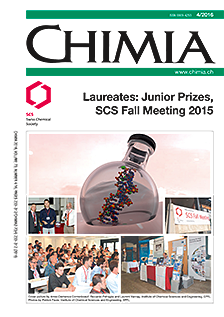Do Hydrogen Bonds Influence Excitonic Splittings?
DOI:
https://doi.org/10.2533/chimia.2016.284Keywords:
Benzonitrile, Meta-cyanophenol, Excitonic splitting, Hydrogen bonds, Vibronic couplingAbstract
The excitonic splitting and vibronic quenching of the inversion-symmetric homodimers of benzonitrile, (BN)2, and meta-cyanophenol, (mCP)2, are investigated by two-color resonant two-photon ionization spectroscopy. These systems have very different hydrogen bond strengths: the OH···N?C bonds in (mCP)2 are ?10 times stronger than the CH···N?C hydrogen bonds in (BN)2. In (BN)2 the S0(1Ag) ? S1(1Ag) transition is electric-dipole forbidden, while the S0(1Ag) ? S2(1Bu) transition is allowed. The opposite holds for (mCP)2 due to the different transition dipole moment vector alignment. The S0 ? S1S2 spectra of the dimers are compared and their excitonic splittings and vibronic quenchings are investigated by measuring the 13C-substituted heterodimer isotopomers, for which the centrosymmetry is broken and both transitions are allowed. The excitonic splittings are determined as ?exc = 2.1 cm–1 for (BN)2 and ?exc = 7.3 cm–1 for (mCP)2. The latter exhibits a much stronger vibronic quenching, as the purely electronic splitting resulting from ab initio calculations is determined to be ?calc = 179 cm–1, while in (BN)2 the calculated splitting is ?calc = 10 cm–1. The monomer site-shifts upon dimerization and comparing certain vibrations that deform the hydrogen bonds confirm that the OH···N?C hydrogen bond is much stronger than the CH···N?C bond. We show that the H-bonds have large effects on the spectral shifts, but little or no influence on the excitonic splitting.Downloads
Published
2016-04-27
Issue
Section
Scientific Articles
License
Copyright (c) 2016 Swiss Chemical Society

This work is licensed under a Creative Commons Attribution-NonCommercial 4.0 International License.
How to Cite
[1]
Chimia 2016, 70, 284, DOI: 10.2533/chimia.2016.284.







